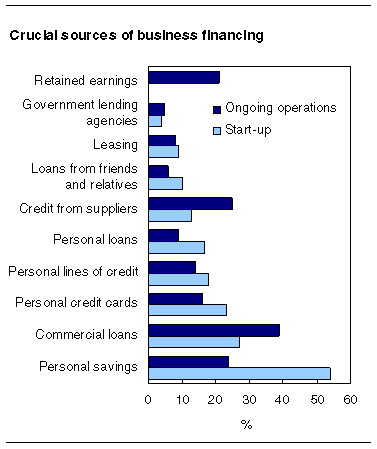
















 |
|
 |                |
Information identified as archived is provided for reference, research or recordkeeping purposes. It is not subject to the Government of Canada Web Standards and has not been altered or updated since it was archived. Please "contact us" to request a format other than those available.

|

Tuesday, October 1, 2002 Financing of small- and medium-sized enterprises2000An entrepreneur's personal savings are twice as important as commercial bank loans in financing the start-up of new businesses, according to data on the capital structure of businesses from the 2000 Survey on Financing of Small and Medium-sized Firms. However, once a business is in operation, commercial bank loans become the single most important source of finance. 
Just over one-half (54%) of entrepreneurs reported that, in 2000, personal savings were very important in launching their business, whereas 27% cited commercial loans from banks, credit unions, caisses populaires or other financial institutions as very important. About 23% of entrepreneurs said they also depended on their personal credit cards. (The survey did not ask whether businesses carried a balance on their credit cards and paid interest on it.) Other major sources of finance were personal lines of credit and personal loans, trade credit from suppliers, loans from friends and relatives, leasing and government lending agencies.
Knowledge-based industries had the lowest debt-to-equity ratio among a group of surveyed industries, as well as the lowest proportion of bank loans on their balance sheets. Statistics Canada conducted the survey, in partnership with Industry Canada and Finance Canada, in the fall of 2001 as part of a larger program of research on small and medium-sized firms. About 7,200 firms answered detailed questions on their credit suppliers and on the capital structure of their businesses. The first round of survey data released in The Daily on January 15 concentrated on debt financing. Data showed that 82% of small and medium-sized enterprises that sought a loan or other type of credit during 2000 were able to obtain it. Start-ups: Importance of commercial loans varies by industryThe importance of commercial loans for business start-ups varied across industries, according to the survey. In agriculture, 62% of firms reported that commercial loans were very important in starting up, as did 39% of firms in manufacturing and the primary industries, and 33% of those in wholesale and retail trade. However, only 6% of firms in the knowledge-based industry and 8% of those in professional service industries reported that commercial loans were important. In contrast, the entrepreneur's personal savings were crucial for starting up businesses in all industries. Personal savings were also more important than commercial loans for businesses of all ranges of employment. Firms with no employees were the least dependent on commercial loans for start-up. Commercial loans were crucial for 31% of companies with 1 to 4 employees, and for 40% of businesses that employed 5 to 19 employees. Ongoing operations: Commercial credit single most important source of financingCommercial credit was the single most important source of financing for ongoing operations, according to the survey. About 39% of respondents identified loans from banks, credit unions, caisses populaires and other financial institutions as very important to financing their ongoing operations, compared with only 24% who cited personal savings. Furthermore, 21% depended on past profits, or retained earnings, for finance. Other sources were credit from suppliers, personal credit cards, personal lines of credit, commercial credit cards and personal loans, leasing, loans from friends or relatives, and factoring. The importance of bank financing varied by the size of the firm. Loans from financial institutions were very important for 32% of firms that had no employees. This proportion rose to 41% among firms with 1 to 4 employees, 53% among those with 5 to 19, 60% among those with 20 to 99, and 69% among those with 100 to 499 employees. Again, the importance of bank financing varied from industry to industry. Only 27% of firms in the professional services industries and 17% in the knowledge-based industries identified access to commercial loans as very important. In contrast, 42% of businesses in the capital-intensive manufacturing industries, as well as 59% of businesses in agriculture, identified access to commercial loans as very important. In knowledge-based industries, 15% of liabilities outstanding were in form of commercial loans, compared with 25% in wholesale and retail trade, 28% in professional services, 31% in manufacturing and 46% in agriculture. Debt-to-equity ratio lowest for knowledge-based firmsThe survey found that 86% of total equity among small and medium-sized enterprises in 2000 was held by the business owner-operators, and the remainder was owned by relatives and friends, private investors, venture capital and others. The capital structure of a small or medium-sized firm depended on the industry in which it operated. Companies in knowledge-based industries had a long-term debt-to-equity ratio of 0.36; in professional services, the ratio was 0.45. Firms operating in the capital-intensive sectors that can offer physical collateral had higher debt-to-equity ratios. For example, manufacturing had a ratio of 0.62 and wholesale and retail trade, 0.64. Information on methods and data quality available in the Integrated Meta Data Base: survey number 2941. To order aggregate data from the survey, now available in table format, contact Client Services (1-877-679-2746). For more information, or to enquire about the concepts, methods or data quality of this release, contact Klaus Kostenbauer (613-951-0691; klaus.kostenbauer@statcan.gc.ca), Small Business and Special Surveys Division. This survey forms part of the SME Financing Data Initiative. For more information on the initiative, please consult Industry Canada's Web site (www.strategis.ic.gc.ca/fdi). |
|
|
|